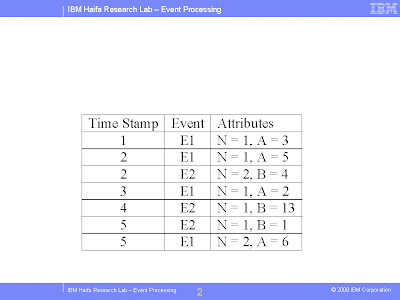2008-10-20T19:05:00.007+02:00

 Still lazy days of the holiday week, I took advantage of the time to help my mother, who decided that she wants to leave home and move to seniors residence located 10 minutes walk from my house, this requires to deal with many details, so that is what I was doing in the last three days.... In the picture above (taken from the residence site) you can see the front entrance and the view seen from the residence tower, on the right hand side of the upper picture one can see part of the neighborhood we are living in (Ramat Begin) surrounded by pine trees all over.
Now, holiday eve again, and this is a good time to visit the Blog again. Last time I started the discussion in the semantics of synonyms by posing a simple example of conjunction over a bounded time interval (same pattern that Hans Glide referred to in his Blog), and slightly different from the "temporal sequence" pattern.
In the previous posting I have posed the following example:
Detect a pattern that consists of conjunction of two events (order is not important) - e1, e2.
Still lazy days of the holiday week, I took advantage of the time to help my mother, who decided that she wants to leave home and move to seniors residence located 10 minutes walk from my house, this requires to deal with many details, so that is what I was doing in the last three days.... In the picture above (taken from the residence site) you can see the front entrance and the view seen from the residence tower, on the right hand side of the upper picture one can see part of the neighborhood we are living in (Ramat Begin) surrounded by pine trees all over.
Now, holiday eve again, and this is a good time to visit the Blog again. Last time I started the discussion in the semantics of synonyms by posing a simple example of conjunction over a bounded time interval (same pattern that Hans Glide referred to in his Blog), and slightly different from the "temporal sequence" pattern.
In the previous posting I have posed the following example:
Detect a pattern that consists of conjunction of two events (order is not important) - e1, e2.
e1 has two attributes = {N, A}; e2 has also two attributes = {N, B} ; the pattern matching is partitioned according to the value of N (on context partitions I'll write another time).
For each detection, create a derived event e3 which includes two attributes = {N, C}; E3 values are derived as: E3.N := E1.N ; E3. C = E1. A * E2. B.
Let's also assume that the relevant temporal context is time-stamps = [1, 5] - and the events of types E1 and E2 that arrived during this period are displayed in the table below:
</span>

The question is: how many instances of event E3 are going to be created, and what will be the values of their attributes?
Looking at this example, for N = 2, there is exactly one pair that matches the pattern
E1 that occurs in timestamp 5, and E2 that occurs in timestamp 4, so E3 will have the attributes {N = 2, C = 24}. However, for N = 1 things are more complicated. If we'll take the set oriented approach that looks at it as "join" (Cartesian product), since we have 3 instances of E1 and two instances of E2, we'll get 6 instances of E3 with all combinations. In some cases we may be interested in all combinations, but typically in event processing we are looking for match and not for join -- that is the difference between "event-at-a-time" type of patterns and "set-at-a-time" patterns that is being used by some of the stream processing semantics. So what is the correct answer ? -- there is no single correct answer, thus what is needed is to fine tune the semantics using policies. For those who are hard-coding event processing, or using imperative event processing languages, this entire issue seems a non-issue, since when they develop the code for a particular case they also build (implicitly) the semantics they require for a specific case, however policies are required when using higher level languages (descriptive, declarative, visual etc...), policies are needed to bridge between the fact that semantics is built-in inside higher level abstraction, and the need to fine-tune the semantics in several cases. In our case we can have several types of policies:
Policies based on order of events - example:
For E1 - select the first instance; for E2 - select the last instance.
For E1 - select the last instance; for E2 - select the last instance
Policies based on values - example:
For E1 - select the highest 2 instances for the value of A ; for E2 select the lowest instance for the value of B.
These are examples only -- it is also important to select a reasonable default which satisfies the "typical case", so if the semantics fits this default, no more action is needed.
These have been examples only, in one of the next postings I'll deal with identifying the set of policies required in order to make the semantics precise.
Source...